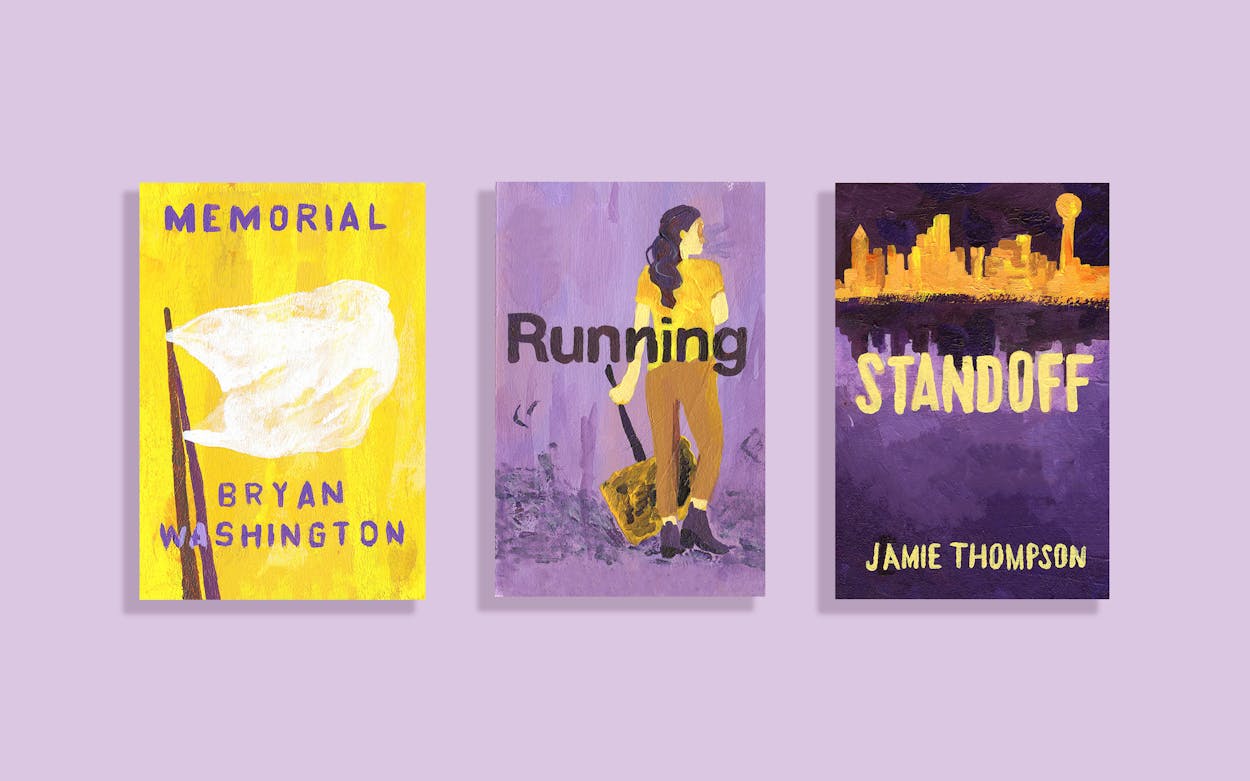Memorial
Bryan Washington, Riverhead Books
Narrated in alternating sections by Mike and Benson, a mixed-race couple living in Houston’s Third Ward, Washington’s first novel explores love, forgiveness, estranged parents, and the power of meals to connect people. (In addition to penning fiction, Washington frequently writes about food for the New Yorker.) The story picks up soon after the two men have a fight; Mike flies to Osaka to visit his dying father, leaving Benson to manage his own father’s worsening alcoholism. Like Lot, Washington’s acclaimed 2019 debut collection of Houston-set short stories, Memorial brims with subtle moments that reveal its characters’ humanity and passion. —Richard Z. Santos
Running
Natalia Sylvester, Clarion Books
A pivotal moment in Austin writer Sylvester’s inspiring young adult novel Running involves actual running. Fifteen-year-old Cuban American Mariana Ruiz finds herself reluctantly pulled into her father’s presidential campaign, and as the pressure to play the role of the perfect “first daughter” intensifies, she flees. But Mari can get only so far before realizing that she can’t escape the truth: the man she believed her father to be is very different from the politician he actually is. — Doyin Oyeniyi
Standoff: Race, Policing, and a Deadly Assault That Gripped a Nation
Jamie Thompson, Henry Holt & Co.
On July 7, 2016, during a Dallas protest against police brutality, a gunman ambushed a group of police officers, leaving five dead and eleven injured. Veteran journalist Thompson pulls the reader deeply into the night’s events by switching among key players, including the mayor, a trauma surgeon trying to save lives, and, most movingly, the police department hostage negotiator who spends hours bonding with the doomed gunman. — R.Z.S.
The Dragon, the Giant, and the Women
Wayétu Moore, Graywolf Press
We are generally discouraged from judging books by their covers, but the same caution needn’t apply to the quote a writer chooses for the epigraph. In the front pages of Moore’s 2020 memoir, The Dragon, the Giant, and the Women, there’s a simple suggestion from the late, great Carrie Fisher—“Take your broken heart, and turn it into art”–that foreshadows what Moore accomplishes in the subsequent 272 pages. Moore’s book is a poetic examination of a childhood trauma unfathomable to most readers. The titular dragons are the Liberian rebels and statesmen who engulfed Moore’s home country in civil war when she was only five. The giant is Moore’s father, who led his family across Liberia, on foot, telling his young daughters that the prone bodies they passed along the way were merely “sleeping.” The women are the author herself, her sisters, her mother, and Satta, the mysterious young rebel who helped Moore’s family cross into Sierra Leone, from which they traveled to the United States, eventually settling in the suburbs of Houston. Moore narrates the bulk of the memoir with prose that is both emotive and playful. But when Dragon, in midstream, switches to her mother’s perspective, it becomes more than just one refugee’s coming-of-age tale, blossoming into a multigenerational meditation on racial and cultural identity, courage, and love. — Emily McCullar
We Are All the Same in the Dark
Julia Heaberlin, Ballantine
Ten years ago, everyone says, Wyatt Branson killed his father and his sister, Trumanell, and then hid their bodies somewhere they’d never be found. The whole town knows it. The cops know. The reporters, the internet sleuths, and the murder mystery shows on cable TV know. Everyone knows. Everyone except police officer Odette Tucker.
Heaberlin’s fifth suspense novel, We Are All the Same in the Dark, is set in a small, nameless East Texas town that’s still mourning Trumanell’s disappearance and is waiting for any excuse to deliver justice—legal or not—to Wyatt. Odette is the town’s youngest cop and Wyatt’s former girlfriend—and just about the only person in town who thinks he might be innocent.
After Wyatt finds a thirteen-year-old girl abandoned in a field and brings her back to his house, Odette is determined to shelter the girl and protect Wyatt from suspicious neighbors. The girl, nicknamed “Angel,” refuses to speak and is missing an eye. Digging into the girl’s past brings up Odette’s own painful memories and soon she’s exploring forgotten leads and uncovering old secrets that many townspeople—including her own family and fellow police officers—would rather remain hidden.
We Are All the Same in the Dark succeeds because Heaberlin is working on three levels—offering a fast-paced thriller centered around Angel and a slow-burning mystery focused on Trumanell, while never losing sight of her characters’ humanity. — R.Z.S.
The Only Good Indians
Stephen Graham Jones, Gallery/Saga Press
The Only Good Indians opens with a brutal murder outside of a roughneck bar in North Dakota and only grows more terrifying from there. Ten years ago, four young men of the Blackfeet tribe—Gabe, Ricky, Cass, and Lewis—crossed into a section of the reservation meant only for the elders to hunt. What happened that day in the blood-soaked snow still haunts them a decade later. The latest novel from Jones, a West Texas native and winner of the TBF’s 2020 Texas Writer Award, takes the well-worn hunter-turned-prey narrative and infuses it with slashing insights about Native identity, racism, cultural expectations, and how past sins can stalk one’s future. Imaginative as it is disturbing and funny as it is gruesome, The Only Good Indians proves again that, in Jones’s hands, the line separating literary fiction and horror vanishes. But a note of warning: after reading this, you may never see an elk without a deep shudder slinking down your spine. — Christian Wallace
A version of this article originally appeared in the November 2020 issue of Texas Monthly with the headline “Three Good Reads.” Subscribe today.










